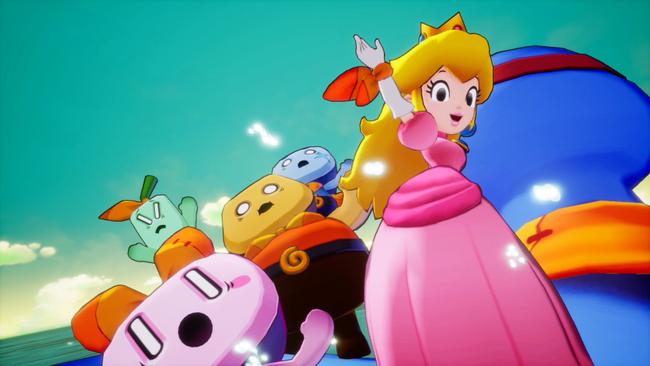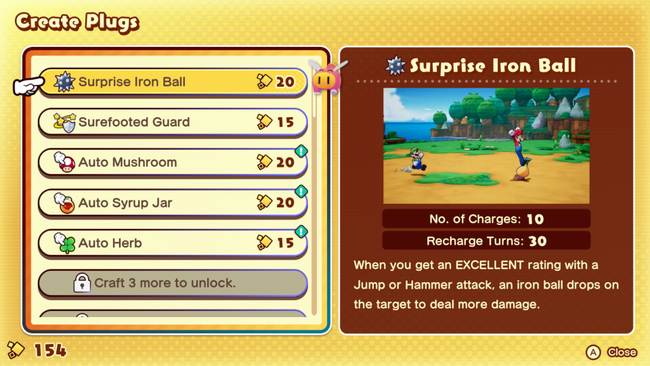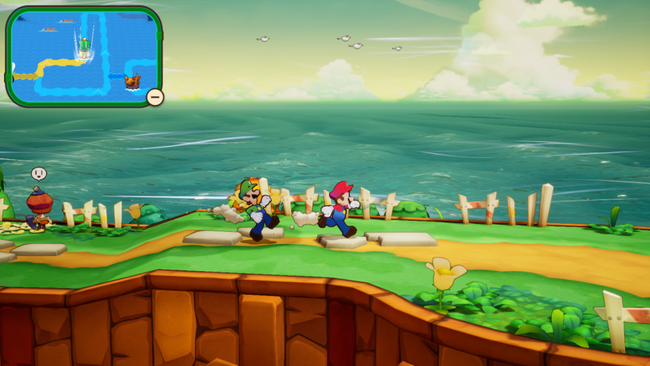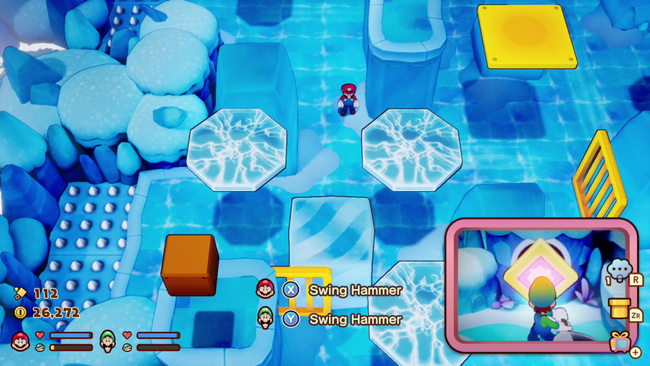
Mario & Luigi: Brothership Review
More than a decade ago, I wrote my very first review for RPG Site. Mario & Luigi: Dream Team was a generally enjoyable RPG that I felt overstayed its welcome, with an extended runtime, tiresome pacing, and overabundant tutorials. Now, comfortably more than 100 published reviews later, Mario & Luigi: Brothership feels like a familiar echo to me; an unfortunate feeling of déjà vu.
I'd like to think that people generally know what to expect when approaching the Mario & Luigi series. You won't get a dramatic role-playing epic with multi-dimensional character writing or sophisticated party-building mechanics, but that's all fine. You hope for a charming, energetic adventure with quirky characters and colorful combat. On that front, Brothership fits the bill, mostly.

The initial narrative setup is easy to grasp. The Mario Bros. are mysteriously warped to a separate realm known as Concordia, which is an ocean-based world where a central Uni-tree connects all the separate islands as a sort of central guiding pillar. However, a malevolent force has destroyed Concordia's Uni-tree, and it's up to Mario & Luigi to aid in the creation of a new Uni-tree to reconnect the islands once again.
The main driving force behind this is Connie, a young Wattanist (like "botanist") who is trying to nurture a new Uni-tree. Her hat appears to be an electrical plug, while her face (and the faces of all Concordians) resembles an electrical socket. This is the game's main visual gimmick, if you couldn't tell, full of circuitry puns and aesthetics. It's cute, maybe a little groan-worthy at times, but I accept it.
Brothership, as may be expected for the first console entry in the series, is by far the most cinematic Mario & Luigi has ever been. In addition to fully rendered characters and environments, there are even a few full sizable choreographed cutscenes in a franchise that was essentially void of them prior. For the most part, I'm content with the series' transition here, even if I'll always have a soft spot for sprite work, and I wish it was a little bit snappier than it is. It did take me a while to get used to the blue-colored shading used throughout, though, which sometimes gives the appearance of color bleed around certain characters.
The narrative focuses heavily on an easily digestible theme of bonds and unity (the world is literally called Concordia). The game even has a slight tinge of shonen anime feel to it, as weird as that may sound, with concepts like friendship and determination very obviously present throughout. It's a simple theming, to be sure, but I can't fault it too much.

The structure of Brothership has the Bros. moving from island to island in Concordia, completing the local scenario to reconnect the island to the Uni-tree, before moving to the next island. Your hub area, Shipshape Island (the titular Brothership, if you will), is not only home to the Uni-tree, but it also can navigate around Concordia's waters, hence its 'shipshape' name. Your ship's current path on Concordia's waters is even permanently plastered to the upper left of the UI at basically all times. Once an island is connected to the Uni-tree on your ship, you can easily revisit it whenever you want, which you may be doing frequently if you like to complete side quests.
Early on in Brothership, a bizarre mechanic is introduced where you can set course for a new island on your Concordia sea chart, but it takes real time to pass before you actually get there. This travel duration can be a solid few minutes if you are traveling far, and the game even suggests that you revisit a previous island while you wait to reach your destination (remember that previously visited islands are connected to your hub ship, so previous isles are making the voyage with you.) A tutorial box even says you can spend your wait grinding to gain levels and money, if you want.

This 'find a way to waste time as you wait for your ship to travel' mechanic is honestly very strange, but luckily, short-lived. Relatively early on in the game, you'll gain a way to make your ship travel significantly faster than it does at the onset, which almost (but not quite) negates the wait time entirely. On one hand, it's nice that the game recognized that this travel mechanic needed alleviation and I'm glad I didn't have to wait for a few minutes each time I wanted to travel somewhere new. On the other hand, though, it makes me wonder why the game even entertained this idea to begin with.
Combat in Brothership should, for the most part, feel familiar to those who have played other Mario & Luigi titles, or Mario RPGs in general (such as the recent Switch ports of Super Mario RPG or The Thousand-Year Door.) Mario and Luigi are your only two battle characters, and while combat is turn-based, the player will need to make certain button inputs for every attack in order for them to be most effective. Most of these inputs are relatively simple, although the combined Bros. Attack will require more complex coordination and timing. This is the sixth entry in the Mario & Luigi series, and the basic fundamentals to combat have become conventional to the franchise.
However, Brothership's emblematic mechanic — new to the series — is the Battle Plug system. While these plugs may at first seem to work similarly to badges like in Paper Mario, adding a variety of effects to your abilities, the implementation is considerably different. Battle Plugs are genuinely novel and add a dynamic element to combat, becoming quite varied and versatile by the end game. Setting a plug gives both Mario & Luigi some specified bonus to augment their battle capabilities. Sometimes it's additional damage after landing an attack with proper timing, or sometimes a plug can cause enemies to become dizzy, or add a splash damage modifier to attacks. There are also auxiliary plugs that improve the functionality of adjacent plugs, despite being useless plugs in isolation. Plug effects can also combine, cleverly stacking their effects in useful ways that might give you the upper hand in battle.

The main things to know about plugs are that 1.) they can be set any time, even during battle, and 2.) they have a limited number of uses and must be recharged, which takes a set number of turns. Unlike badges in similar games, which you mostly prepare ahead of time, set, and forget, plugs instead will be constantly shuffling in and out of your loadout. The functionality starts a bit restricted and limited, but it comes into form as you make your way further and further into Brothership.
As an example of how this might work, later in the game, I would try to go into battle with plugs that not only improve my Bros. Attack damage, but also automatically executed the player inputs to perfection. I would also attach plugs that increase the charges available for these powered-up attacks, basically allowing me to dish out high amounts of damage early. After exhausting the plugs for my souped-up Bros. Attacks, I would then switch those plugs out in favor of more defensive ones that reduce my damage received or made counters easier to execute. For some of the more challenging optional bosses, good plug shuffling ends up being a significant portion of your battle aptitude.
That said, I actually wish Brothership went a little bit deeper here. There are some obvious synergies between certain plugs, but once you find those few combinations, there's not as much material to experiment with as I would have liked. Also, plugs can only be recharged when they reach 0 uses, which feels a little bit arbitrary to work around (imagine if you could only charge your phone when it reaches 0% battery and not a moment before). Still, I think the Battle Plug component is one of Brothership's successes, and I hope it gets expanded upon somewhere down the line.

Unfortunately, while I think the battle system mechanics are well-thought and compelling, Brothership falters severely in other ways. My primary takeaway from Brothership is more-or-less the same as what I said about Dream Team eleven years ago: the game is simply too long for its own good, with my final playtime surpassing 40 hours when including all side content. Bluntly, I was ready for the game to be over 15-to-20 hours before the credits actually rolled.
Game length itself is not necessarily a problem, of course. There are plenty of RPGs well longer than Brothership that are excellent. RPGs come in many forms, however, and Mario & Luigi RPGs are not well suited to lengthy adventures. And nor do they need to be; Superstar Saga and Bowser's Inside Story are generally beloved games that clocked in the 20-25 hour range. M&L progression mechanics, by design, don't offer as much variety as other RPGs do. You'll get a few new Bros. Attacks as you progress through the game, and the aforementioned Battle Plugs offer some wrinkles, but for the most part, you'll be seeing the same jump and hammer animations many times over.
It feels like everything in Brothership takes about 25% longer than it should, from battles, to dialogue sequences, to storyline lengths, and cutscene duration. There are also numerous tutorials scattered throughout up until the end of the game, and I couldn't help but recall similar takeaways to earlier games in the series. I'm thankful there's a dialogue speed-up option, at least, even if it only seems to up the pace slightly. There are also no "Giant Dream Luigi" sections to slow things down, either.
While "the game is too damn long" is only a single criticism on paper, this exhausting pacing seeps into nearly every facet of the game. There are too many battles. There are too many tutorials. A few of the individual islands probably could have been cut entirely. Battles probably take too long. Dialogue is often circuitous (pun intended) where characters often repeat the topic at hand numerous times. There are a few goose chases included that feel like they don't have anything to do with anything. The narrative has one or two more turns than it needs. Brothership also has a bad habit of recycling concepts narratively and mechanically. I was drained by the end, and unfortunately this isn't the first time I've felt that in a Mario & Luigi title.

I have to wonder if, being the first full-priced $60 game in the series, the developers felt like they needed to achieve a certain play duration for the product to be more appealing to would-be purchasers. Superstar Saga — the first game in the series — is still excellent, but I suppose it can be difficult to justify spending a full sixty dollars on a 20-hour game had Mario & Luigi been a console entry years and years ago. It is what it is, though, and I suppose the best advice I can give to those diving into Brothership is that you might need to practice some patience on the journey.
As a Switch exclusive, it's unfortunate but predictable that Brothership's performance is shackled by the system it is on. Performance is a problem, broadly, as the game often fails to maintain a steady framerate throughout most of its runtime, and the game would have benefitted tremendously from a 60 FPS framerate that it doesn't have. I can't help but wonder if this game should have waited for the next generation Nintendo system, but unfortunately, that's a sentiment that has become too commonplace with Nintendo games over the years.
Mario & Luigi Brothership is the biggest and boldest the series has ever been, with some novel battle mechanics and colorful presentation. However, an overstuffed runtime and exhausting pacing severely dilute the experience in both narrative and gameplay. Had Brothership been a snappier, more compact entry, it could have been one of the best in the series, but as it is, we're left with an enjoyable game that overstays its welcome once again.